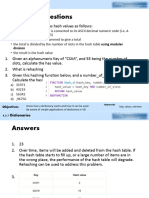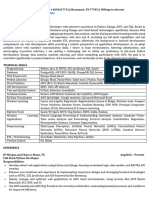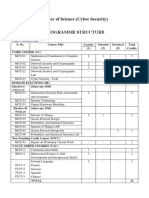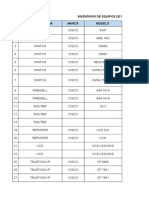Python Code
Uploaded by
Vijendra SinghPython Code
Uploaded by
Vijendra Singh9/6/2019 Python Mandatory Assignment - Jupyter Notebook
Python: without numpy or sklearn
Q1: Given two matrices please print the product of those two matrices
Ex 1: A = [[1 3 4]
[2 5 7]
[5 9 6]]
B = [[1 0 0]
[0 1 0]
[0 0 1]]
A*B = [[1 3 4]
[2 5 7]
[5 9 6]]
Ex 2: A = [[1 2]
[3 4]]
B = [[1 2 3 4 5]
[5 6 7 8 9]]
A*B = [[11 14 17 20 23]
[18 24 30 36 42]]
Ex 3: A = [[1 2]
[3 4]]
B = [[1 4]
[5 6]
[7 8]
[9 6]]
A*B =Not possible
localhost:8888/notebooks/MACHINE_LEARNING/ASSIGNMENT_QUESTIONS/Python Mandatory Assignment.ipynb 1/19
9/6/2019 Python Mandatory Assignment - Jupyter Notebook
In [3]: # Q1: Given two matrices please print the product of those two matrices.
def makeMatrix():
'''This function creats a matrix by taking row and column values as inputs''
r = int(input("Enter the max row :"))
c = int(input("Enter the max column :"))
print("Enter the numbers in a row wise :")
matrix = [[int(input("Element ({0},{1}):".format(i, j)))for j in range(c)]for
return matrix
def printMatrix(matrix):
'''This function prints the matrix by taking matrix as argument'''
for r in matrix:
print(r)
def multiplyMatrix(matrix1, matrix2):
'''This function multiplies two matrices by taking them both as arguments'''
r1 = len(matrix1)
c1 = len(matrix1[0])
r2 = len(matrix2)
c2 = len(matrix2[0])
if(c1 != r2):
print("\nMatrices are incompatible for multiplication")
return 0
else:
result = [[0 for j in range(c2)]for i in range(r1)]
for i in range(r1):
for j in range(c2):
for k in range(r2):
result[i][j] += matrix1[i][k]*matrix2[k][j]
return result
print("Try matrix multiplication here.")
print("\nGive the first matrix")
matrix1 = makeMatrix()
#matrix1 = [[1, 3, 4], [2, 5, 7], [5, 9, 6]]
print("\nGive the second matrix")
matrix2 = makeMatrix()
#matrix2 = [[1, 0, 0], [0, 1, 0], [0, 0, 1]]
print("\nMatrices are")
print("\nFirst matrix")
printMatrix(matrix1)
print("\nSecond matrix")
printMatrix(matrix2)
result = multiplyMatrix(matrix1, matrix2)
if(result != 0):
print("\nResultant matrix")
printMatrix(result)
Try matrix multiplication here.
Give the first matrix
Enter the max row :2
Enter the max column :2
Enter the numbers in a row wise :
Element (0,0):1
Element (0,1):2
localhost:8888/notebooks/MACHINE_LEARNING/ASSIGNMENT_QUESTIONS/Python Mandatory Assignment.ipynb 2/19
9/6/2019 Python Mandatory Assignment - Jupyter Notebook
Element (1,0):1
Element (1,1):2
Give the second matrix
Enter the max row :2
Enter the max column :2
Enter the numbers in a row wise :
Element (0,0):1
Element (0,1):0
Element (1,0):0
Element (1,1):1
Matrices are
First matrix
[1, 2]
[1, 2]
Second matrix
[1, 0]
[0, 1]
Resultant matrix
[1, 2]
[1, 2]
Q2: Select a number randomly with probability proportional to its
magnitude from the given array of n elements
consider an experiment, selecting an element from the list A randomly with probability proportional
to its magnitude. assume we are doing the same experiment for 100 times with replacement, in
each experiment you will print a number that is selected randomly from A.
Ex 1: A = [0 5 27 6 13 28 100 45 10 79]
let f(x) denote the number of times x getting selected in 100 experiment
s.
f(100) > f(79) > f(45) > f(28) > f(27) > f(13) > f(10) > f(6) > f(5) > f
(0)
localhost:8888/notebooks/MACHINE_LEARNING/ASSIGNMENT_QUESTIONS/Python Mandatory Assignment.ipynb 3/19
9/6/2019 Python Mandatory Assignment - Jupyter Notebook
In [7]: # Q2: Select a number randomly with probability proportional to its magnitude fro
from random import uniform
lst = []
size = int(input("Enter the size of the list : "))
print("Enter {0} numbers ".format(size))
for i in range(size):
lst.append(int(input()))
#Removing duplicates from the list if exists
l2s = set(lst)
lst = list(l2s)
#A bigger list for storing the values repetitively based on their magnitudes
bigList = []
for i in lst:
for j in range(i):
bigList.append(i)
#Finding the length of the bigger list
bigListLen = len(bigList)
print("\n\nRandom picking 100 numbers from the list based on probability proporti
for i in range(100):
x = int(uniform(0, bigListLen))
print(bigList[x], end = ", ")
Enter the size of the list : 4
Enter 4 numbers
4
23
12
100
Random picking 100 numbers from the list based on probability proportional to i
ts magnitude
100, 100, 100, 100, 23, 100, 23, 100, 23, 100, 100, 100, 100, 100,
100, 100, 100, 100, 100, 12, 100, 100, 23, 100, 100, 100, 100, 4,
100, 100, 100, 100, 100, 100, 100, 100, 23, 100, 100, 100, 100, 10
0, 12, 23, 100, 100, 12, 4, 100, 100, 100, 100, 100, 100, 100, 10
0, 100, 100, 100, 100, 100, 100, 100, 100, 100, 100, 100, 100, 10
0, 100, 100, 100, 100, 100, 100, 23, 100, 23, 100, 100, 100, 23,
100, 100, 100, 100, 100, 100, 100, 23, 100, 100, 100, 23, 100, 23,
100, 4, 100, 23,
Q3: Replace the digits in the string with #
Consider a string that will have digits in that, we need to remove all the characters which are not
digits and replace the digits with #
localhost:8888/notebooks/MACHINE_LEARNING/ASSIGNMENT_QUESTIONS/Python Mandatory Assignment.ipynb 4/19
9/6/2019 Python Mandatory Assignment - Jupyter Notebook
Ex 1: A = 234 Output: ###
Ex 2: A = a2b3c4 Output: ###
Ex 3: A = abc Output: (empty string)
Ex 5: A = #2a$#b%c%561# Output: ####
In [8]: # Q3: Replace the digits in the string with #
import re
def digit2Hash(string):
_string = ""
pattern = re.compile(r'\d')
matches = pattern.findall(string)
for match in matches:
_string += "#"
return _string
string = input("Enter the string : ")
print(digit2Hash(string))
Enter the string : g4vlrg2vlvlj24v^$$$$$ce65cE
######
Q4: Students marks dashboard
Consider the marks list of class students given in two lists
Students =
['student1','student2','student3','student4','student5','student6','student7','student8','student9','student
Marks = [45, 78, 12, 14, 48, 43, 45, 98, 35, 80]
from the above two lists the Student[0] got Marks[0], Student[1] got Marks[1] and so on.
Your task is to print the name of students
a. Who got top 5 ranks, in the descending order of marks
b. Who got least 5 ranks, in the increasing order of marks
d. Who got marks between >25th percentile <75th percentile, in the increasing order of
marks.
localhost:8888/notebooks/MACHINE_LEARNING/ASSIGNMENT_QUESTIONS/Python Mandatory Assignment.ipynb 5/19
9/6/2019 Python Mandatory Assignment - Jupyter Notebook
Ex 1:
Students=['student1','student2','student3','student4','student5','studen
t6','student7','student8','student9','student10']
Marks = [45, 78, 12, 14, 48, 43, 47, 98, 35, 80]
a.
student8 98
student10 80
student2 78
student5 48
student7 47
b.
student3 12
student4 14
student9 35
student6 43
student1 45
c.
student9 35
student6 43
student1 45
student7 47
student5 48
localhost:8888/notebooks/MACHINE_LEARNING/ASSIGNMENT_QUESTIONS/Python Mandatory Assignment.ipynb 6/19
9/6/2019 Python Mandatory Assignment - Jupyter Notebook
In [1]: # Q4: Students marks dashboard
numOfStudents = int(input("Enter the number of students "))
Students = []
Marks = []
print("\nEnter Names")
for i in range(1, numOfStudents+1):
Students.append(input("Name of student {0} : ".format(i)))
totalMarks = int(input("\nEnter Total Marks : "))
print("\nEnter Obtained Marks")
for i in range(0, numOfStudents):
Marks.append(int(input("Mark of student {0} : ".format(Students[i]))))
Len = len(Students)
keepTrack = dict()
for i in range(Len):
keepTrack[Students[i]] = Marks[i]
_keepMarks = sorted(keepTrack.values(), reverse = True)
def findKey(value):
for k, v in keepTrack.items():
if v == value:
return k
# a. Who got top 5 ranks, in the descending order of marks
print("\n>Students who got top 5 ranks, in the descending order of marks\n")
for i in range(5):
value = _keepMarks[i]
print(findKey(value),"-",value)
# b. Who got least 5 ranks, in the increasing order of marks
print("\n>Students who got least 5 ranks, in the increasing order of marks\n")
_keepMarks = sorted(keepTrack.values())
for i in range(5):
value = _keepMarks[i]
print(findKey(value),"-",value)
# d. Who got marks between >25th percentile <75th percentile, in the increasing o
print("\n>Students who got marks between >25th percentile <75th percentile, in th
for i in range(numOfStudents):
value = _keepMarks[i]
if (0.25*totalMarks) < value < (0.75*totalMarks):
value = _keepMarks[i]
print(findKey(value),"-",value)
Enter the number of students 10
Enter Names
Name of student 1 : a
Name of student 2 : b
Name of student 3 : c
Name of student 4 : d
Name of student 5 : e
Name of student 6 : f
Name of student 7 : g
Name of student 8 : h
localhost:8888/notebooks/MACHINE_LEARNING/ASSIGNMENT_QUESTIONS/Python Mandatory Assignment.ipynb 7/19
9/6/2019 Python Mandatory Assignment - Jupyter Notebook
Name of student 9 : i
Name of student 10 : j
Enter Total Marks : 10
Enter Obtained Marks
Mark of student a : 1
Mark of student b : 2
Mark of student c : 3
Mark of student d : 4
Mark of student e : 5
Mark of student f : 6
Mark of student g : 7
Mark of student h : 8
Mark of student i : 9
Mark of student j : 10
>Students who got top 5 ranks, in the descending order of marks
j - 10
i - 9
h - 8
g - 7
f - 6
>Students who got least 5 ranks, in the increasing order of marks
a - 1
b - 2
c - 3
d - 4
e - 5
>Students who got marks between >25th percentile <75th percentile, in the inc
reasing order of marks
c - 3
d - 4
e - 5
f - 6
g - 7
Q5: Find the closest points
Consider you are given n data points in the form of list of tuples like S=[(x1,y1),(x2,y2),(x3,y3),
(x4,y4),(x5,y5),..,(xn,yn)] and a point P=(p,q)
your task is to find 5 closest points(based on cosine distance) in S from P
Cosine distance between two points (x,y) and (p,q) is defined as 𝑐𝑜𝑠−1 ( √(𝑥2+(𝑥⋅𝑝+𝑦⋅𝑞)
𝑦2 )⋅√(𝑝2 +𝑞2 ) )
localhost:8888/notebooks/MACHINE_LEARNING/ASSIGNMENT_QUESTIONS/Python Mandatory Assignment.ipynb 8/19
9/6/2019 Python Mandatory Assignment - Jupyter Notebook
Ex:
S= [(1,2),(3,4),(-1,1),(6,-7),(0, 6),(-5,-8),(-1,-1)(6,0),(1,-1)]
P= (3,-4)
Output:
(6,-7)
(1,-1)
(6,0)
(-5,-8)
(-1,-1)
localhost:8888/notebooks/MACHINE_LEARNING/ASSIGNMENT_QUESTIONS/Python Mandatory Assignment.ipynb 9/19
9/6/2019 Python Mandatory Assignment - Jupyter Notebook
In [10]: # Q5: Find the closest points
import math
S = []
numOfPoints = int(input("Enter the total number of close points : "))
print("Enter points")
for i in range(numOfPoints):
S.append(tuple(int(x) for x in input().split(',')))
print(S)
sLen= len(S)
P= tuple(int(x) for x in input("\nEnter the point from which close points has to
resList = []
p, q = P
for i in S:
x, y = i
resList.append(math.acos((x*p+y*q)/(math.sqrt(x*x + y*y)*math.sqrt(p*p + q*q)
distanceDict = {}
for i in range(sLen):
distanceDict[S[i]] = resList[i]
distanceValue = sorted(distanceDict.values())
def findKey(value):
for k, v in distanceDict.items():
if v == value:
return k
print("\nClosest points :\n")
for i in range(5):
key = findKey(distanceValue[i])
print(key, distanceValue[i])
Enter the total number of close points : 9
Enter points
1,2
3,4
-1,1
6,-7
0, 6
-5,-8
-1,-1
6,0
1,-1
[(1, 2), (3, 4), (-1, 1), (6, -7), (0, 6), (-5, -8), (-1, -1), (6, 0), (1, -1)]
Enter the point from which close points has to be found : 3,-4
Closest points :
(6, -7) 0.06512516333438509
(1, -1) 0.14189705460416438
(6, 0) 0.9272952180016123
(-5, -8) 1.2021004241368467
(-1, -1) 1.4288992721907328
localhost:8888/notebooks/MACHINE_LEARNING/ASSIGNMENT_QUESTIONS/Python Mandatory Assignment.ipynb 10/19
9/6/2019 Python Mandatory Assignment - Jupyter Notebook
In [ ]:
Q6: Find which line separates oranges and apples
Consider you are given two set of data points in the form of list of tuples like
Red =[(R11,R12),(R21,R22),(R31,R32),(R41,R42),(R51,R52),..,(Rn1,Rn2)]
Blue=[(B11,B12),(B21,B22),(B31,B32),(B41,B42),(B51,B52),..,(Bm1,Bm2)]
and set of line equations(in the string format, i.e list of strings)
Lines = [a1x+b1y+c1,a2x+b2y+c2,a3x+b3y+c3,a4x+b4y+c4,..,K lines]
Note: You need to do string parsing here and get the coefficients of x,y
and intercept.
Your task here is to print "YES"/"NO" for each line given. You should print YES, if all the red points
are one side of the line and blue points are on other side of the line, otherwise you should print
NO.
localhost:8888/notebooks/MACHINE_LEARNING/ASSIGNMENT_QUESTIONS/Python Mandatory Assignment.ipynb 11/19
9/6/2019 Python Mandatory Assignment - Jupyter Notebook
Ex:
Red= [(1,1),(2,1),(4,2),(2,4), (-1,4)]
Blue= [(-2,-1),(-1,-2),(-3,-2),(-3,-1),(1,-3)]
Lines=["1x+1y+0","1x-1y+0","1x+0y-3","0x+1y-0.5"]
Output:
YES
NO
NO
YES
localhost:8888/notebooks/MACHINE_LEARNING/ASSIGNMENT_QUESTIONS/Python Mandatory Assignment.ipynb 12/19
9/6/2019 Python Mandatory Assignment - Jupyter Notebook
In [6]: # Q6: Find which line separates oranges and apples
import re
Red= []
Blue= []
Lines=[]
numOfPoints = int(input("Enter the total number of Red points : "))
print("Enter points :")
for i in range(numOfPoints):
Red.append(tuple(int(x) for x in input().split(',')))
numOfPoints = int(input("Enter the total number of Blue points : "))
print("Enter points :")
for i in range(numOfPoints):
Blue.append(tuple(int(x) for x in input().split(',')))
numOfEqu = int(input("Enter the number of equations : "))
print("Enter equations :")
for i in range(numOfEqu):
Lines.append(input())
seperateRed = []
seperateBlue = []
def doesItSeperate(a, b, c):
'''This function will find if all the red and blue points are seperated from
for i in Red:
#Checking if all the red points are seperated from the line
x, y = i
res = a*x + b*y
if(res>c):
seperateRed.append(True)
else:
seperateRed.append(False)
for i in Blue:
#Checking if all the blue points are seperated from the line
x, y = i
res = a*x + b*y
if(res<c):
seperateBlue.append(True)
else:
seperateBlue.append(False)
#If all the red and blue points are seperated return Yes else No
if(all(seperateRed) and all(seperateBlue)):
print("Yes")
else:
print("No")
seperateRed.clear()
seperateBlue.clear()
for line in Lines:
a, b, c = tuple(float(i.strip()) for i in re.split('x|y', line))
localhost:8888/notebooks/MACHINE_LEARNING/ASSIGNMENT_QUESTIONS/Python Mandatory Assignment.ipynb 13/19
9/6/2019 Python Mandatory Assignment - Jupyter Notebook
doesItSeperate(a, b, c)
Enter the total number of Red points : 2
Enter points :
1,2
1,3
Enter the total number of Blue points : 3
Enter points :
2,3
1,2
9,3
Enter the number of equations : 2
Enter equations :
1x+1y+0
1x-1y+1
No
No
Q7: Filling the missing values in the specified format
You will be given a string with digits and '_'(missing value) symbols you have to replace the '_'
symbols as explained
Ex 1: _, _, _, 24 ==> 24/4, 24/4, 24/4, 24/4 i.e we. have distributed th
e 24 equally to all 4 places
Ex 2: 40, _, _, _, 60 ==> (60+40)/5,(60+40)/5,(60+40)/5,(60+40)/5,(60+4
0)/5 ==> 20, 20, 20, 20, 20 i.e. the sum of (60+40) is distributed quall
y to all 5 places
Ex 3: 80, _, _, _, _ ==> 80/5,80/5,80/5,80/5,80/5 ==> 16, 16, 16, 16, 1
6 i.e. the 80 is distributed qually to all 5 missing values that are rig
ht to it
Ex 4: _, _, 30, _, _, _, 50, _, _
==> we will fill the missing values from left to right
a. first we will distribute the 30 to left two missing values (10, 1
0, 10, _, _, _, 50, _, _)
b. now distribute the sum (10+50) missing values in between (10, 10,
12, 12, 12, 12, 12, _, _)
c. now we will distribute 12 to right side missing values (10, 10, 1
2, 12, 12, 12, 4, 4, 4)
for a given string with comma seprate values, which will have both missing values numbers like ex:
"_, _, x, _, _, _" you need fill the missing values
Q: your program reads a string like ex: "_, _, x, _, _, _" and returns the filled sequence
Ex:
localhost:8888/notebooks/MACHINE_LEARNING/ASSIGNMENT_QUESTIONS/Python Mandatory Assignment.ipynb 14/19
9/6/2019 Python Mandatory Assignment - Jupyter Notebook
Input1: "_,_,_,24"
Output1: 6,6,6,6
Input2: "40,_,_,_,60"
Output2: 20,20,20,20,20
Input3: "80,_,_,_,_"
Output3: 16,16,16,16,16
Input4: "_,_,30,_,_,_,50,_,_"
Output4: 10,10,12,12,12,12,4,4,4
localhost:8888/notebooks/MACHINE_LEARNING/ASSIGNMENT_QUESTIONS/Python Mandatory Assignment.ipynb 15/19
9/6/2019 Python Mandatory Assignment - Jupyter Notebook
In [5]: # Q7: Filling the missing values in the specified format
#string = "_, _, 30, _, _, _, 50, _, _"
#string = " _, _, _, 24"
#string = "40, _, _, _, 60"
#string = "80, _, _, _, _ "
string = input("Enter the string : ")
string = string.strip()
seperated = string.split(", ")
left = 0
right = len(seperated)
count = 1
lastSeen = 0
def lastSeenToseen(lastSeen, seen, base, val1, val2):
seen+=1
if base == 1:
pass
else:
for i in range(lastSeen, seen):
seperated[i] = int((val1+val2)/base)
return
for i in range(right):
if seperated[i] == "_":
seperated[i] = 0
else:
seperated[i] = int(seperated[i])
while(left < right):
if seperated[left] != 0:
seen = left
base = seen - lastSeen + 1
lastSeenToseen(lastSeen, seen, base, seperated[lastSeen], seperated[seen
lastSeen = seen
if count == right:
if seperated[left] == 0:
seen = right - 1
base = seen - lastSeen + 1
lastSeenToseen(lastSeen, seen, base, seperated[lastSeen], seperated[s
left += 1
count +=1
print(seperated)
Enter the string : _, _, 30, _, _, _, 50, _, _
[10, 10, 12, 12, 12, 12, 4, 4, 4]
Q8: Find the probabilities
You will be given a list of lists, each sublist will be of length 2 i.e. [[x,y],[p,q],[l,m]..[r,s]] consider its
like a martrix of n rows and two columns
1. The first column F will contain only 5 uniques values (F1, F2, F3, F4, F5)
2. The second column S will contain only 3 uniques values (S1, S2, S3)
localhost:8888/notebooks/MACHINE_LEARNING/ASSIGNMENT_QUESTIONS/Python Mandatory Assignment.ipynb 16/19
9/6/2019 Python Mandatory Assignment - Jupyter Notebook
your task is to find
a. Probability of P(F=F1|S==S1), P(F=F1|S==S2), P(F=F1|S==S3)
b. Probability of P(F=F2|S==S1), P(F=F2|S==S2), P(F=F2|S==S3)
c. Probability of P(F=F3|S==S1), P(F=F3|S==S2), P(F=F3|S==S3)
d. Probability of P(F=F4|S==S1), P(F=F4|S==S2), P(F=F4|S==S3)
e. Probability of P(F=F5|S==S1), P(F=F5|S==S2), P(F=F5|S==S3)
Ex:
[[F1,S1],[F2,S2],[F3,S3],[F1,S2],[F2,S3],[F3,S2],[F2,S1],[F4,S1],[F4,S
3],[F5,S1]]
a. P(F=F1|S==S1)=1/4, P(F=F1|S==S2)=1/3, P(F=F1|S==S3)=0/3
b. P(F=F2|S==S1)=1/4, P(F=F2|S==S2)=1/3, P(F=F2|S==S3)=1/3
c. P(F=F3|S==S1)=0/4, P(F=F3|S==S2)=1/3, P(F=F3|S==S3)=1/3
d. P(F=F4|S==S1)=1/4, P(F=F4|S==S2)=0/3, P(F=F4|S==S3)=1/3
e. P(F=F5|S==S1)=1/4, P(F=F5|S==S2)=0/3, P(F=F5|S==S3)=0/3
In [4]: # Q8: Find the probabilities
def appearTogether(valF, valS, F, S, aLen):
sCount = 0
fCount = 0
for i in range(aLen):
if valS == S[i]:
sCount+=1
for i in range(aLen):
if(F[i]==valF and S[i]==valS):
fCount+=1
print("Probablity is : {0}/{1}".format(fCount,sCount))
A = [["F1","S1"], ["F2","S2"], ["F3","S3"], ["F1","S2"], ["F2","S3"], ["F3","S2"
F = list()
S = list()
aLen = len(A)
for i in range(aLen):
F.append(A[i][0])
S.append(A[i][1])
print("Find probablity of F with respect to S")
valF = input("Enter F value : ")
valS = input("Enter S value : ")
appearTogether(valF.upper(), valS.upper(), F, S, aLen)
Find probablity of F with respect to S
Enter F value : f1
Enter S value : s3
Probablity is : 0/3
Q9: Operations on sentences
localhost:8888/notebooks/MACHINE_LEARNING/ASSIGNMENT_QUESTIONS/Python Mandatory Assignment.ipynb 17/19
9/6/2019 Python Mandatory Assignment - Jupyter Notebook
You will be given two sentances S1, S2 your task is to find
a. Number of common words between S1, S2
b. Words in S1 but not in S2
c. Words in S2 but not in S1
Ex:
S1= "the first column F will contain only 5 unique values"
S2= "the second column S will contain only 3 unique values"
Output:
a. 7
b. ['first','F','5']
c. ['second','S','3']
In [3]: # Q9: Operations on sentences
#S1= "the first column F will contain only 5 unique values"
#S2= "the second column S will contain only 3 unique values"
print("Enter two sentences :")
S1 = input("Sentence 1 :")
S2 = input("Sentence 2 :")
S1 = S1.split(" ")
S1 = set(S1)
S2 = S2.split(" ")
S2 = set(S2)
print()
# a. Number of common words between S1, S2
print("a> Number of common words between Sentence 1, Sentence 2 : ",len(S1.inters
# b. Words in S1 but not in S2
print("b> Words in Sentence 1 but not in Sentence 2 : ",S1 - S2)
# b. Words in S2 but not in S1
print("b> Words in Sentence 2 but not in Sentence 1 : ",S2 - S1)
Enter two sentences :
a> Number of common words between Sentence 1, Sentence 2 : 7
b> Words in Sentence 1 but not in Sentence 2 : {'F', '5', 'first'}
b> Words in Sentence 2 but not in Sentence 1 : {'3', 'S', 'second'}
Q10: Error Function
You will be given a list of lists, each sublist will be of length 2 i.e. [[x,y],[p,q],[l,m]..[r,s]] consider its
like a martrix of n rows and two columns
a. the first column Y will contain interger values
b. the second column 𝑌𝑠𝑐𝑜𝑟𝑒 will be having float values
Your task is to find the value of
𝑓(𝑌, 𝑌𝑠𝑐𝑜𝑟𝑒 ) = −1 ∗ 1𝑛 Σ𝑓𝑜𝑟𝑒𝑎𝑐ℎ𝑌,𝑌𝑠𝑐𝑜𝑟𝑒𝑝𝑎𝑖𝑟 (𝑌𝑙𝑜𝑔10(𝑌𝑠𝑐𝑜𝑟𝑒 ) + (1 − 𝑌)𝑙𝑜𝑔10(1 − 𝑌𝑠𝑐𝑜𝑟𝑒 )) here n is
the number of rows in the matrix
localhost:8888/notebooks/MACHINE_LEARNING/ASSIGNMENT_QUESTIONS/Python Mandatory Assignment.ipynb 18/19
9/6/2019 Python Mandatory Assignment - Jupyter Notebook
Ex:
[[1, 0.4], [0, 0.5], [0, 0.9], [0, 0.3], [0, 0.6], [1, 0.1], [1, 0.9],
[1, 0.8]]
output:
0.44982
−1 ⋅ ((1 ⋅ 𝑙𝑜𝑔10 (0.4) + 0 ⋅ 𝑙𝑜𝑔10 (0.6)) + (0 ⋅ 𝑙𝑜𝑔10 (0.5) + 1 ⋅ 𝑙𝑜𝑔10 (0.5))+...+(1 ⋅ 𝑙𝑜𝑔10 (0.8) +
8
In [2]: # Q10: Error Function
import math
X = [[1, 0.4],
[0, 0.5],
[0, 0.9],
[0, 0.3],
[0, 0.6],
[1, 0.1],
[1, 0.9],
[1, 0.8]]
def errorFunction(X):
xLen = len(X)
A = []
B = []
for i in range(xLen):
A.append(X[i][0])
B.append(X[i][1])
res = 0
for i in range(xLen):
y = A[i]
Y = B[i]
res += ((y*math.log10(Y)+(1-y)*math.log10(1-Y)))
return res
#r = int(input("Enter the number of elements : "))
#print("Enter the elements ")
#X = [[float(input("Element ({0},{1}):".format(i, j)))for j in range(2)]for i in
res = errorFunction(X)
print(0-res/8)
0.42430993457031635
In [ ]:
localhost:8888/notebooks/MACHINE_LEARNING/ASSIGNMENT_QUESTIONS/Python Mandatory Assignment.ipynb 19/19
You might also like
- 12 Comp Sci 1 Revision Notes Pythan Advanced ProgNo ratings yet12 Comp Sci 1 Revision Notes Pythan Advanced Prog5 pages
- Review of Basic Statistical Concepts HankeNo ratings yetReview of Basic Statistical Concepts Hanke28 pages
- Coding Interview Python Language EssentialsNo ratings yetCoding Interview Python Language Essentials5 pages
- Python Regular Expression - Exercises, Practice, Solution - W3resource12No ratings yetPython Regular Expression - Exercises, Practice, Solution - W3resource121 page
- International Indian School, Riyadh WORKSHEET (2020-2021) Grade - Xii - Informatics Practices - Second TermNo ratings yetInternational Indian School, Riyadh WORKSHEET (2020-2021) Grade - Xii - Informatics Practices - Second Term9 pages
- CSE 1001 (Python) Faculty Name: Dr. AMIT Kumar TyagiNo ratings yetCSE 1001 (Python) Faculty Name: Dr. AMIT Kumar Tyagi16 pages
- Download Discontinuous deformation analysis in rock mechanics practice 1st Edition Yossef H. Hatzor ebook All Chapters PDF100% (9)Download Discontinuous deformation analysis in rock mechanics practice 1st Edition Yossef H. Hatzor ebook All Chapters PDF85 pages
- Python - Adv - 1 - Jupyter Notebook (Student)No ratings yetPython - Adv - 1 - Jupyter Notebook (Student)27 pages
- DataGrokr Technical Assignment - Data Engineering - InternshalaNo ratings yetDataGrokr Technical Assignment - Data Engineering - Internshala5 pages
- Resume - SujanGyawali - Full Stack Python DeveloperNo ratings yetResume - SujanGyawali - Full Stack Python Developer3 pages
- Python 3 Beginner's Reference Cheat Sheet: by Via100% (1)Python 3 Beginner's Reference Cheat Sheet: by Via1 page
- Introduction To Python Programming: Dr. R. Rajeswara Rao Professor & Head Dept. of CSE Jntuk-Ucev VizianagaramNo ratings yetIntroduction To Python Programming: Dr. R. Rajeswara Rao Professor & Head Dept. of CSE Jntuk-Ucev Vizianagaram27 pages
- Python OS Module - 30 Most Useful Methods From Python OS ModuleNo ratings yetPython OS Module - 30 Most Useful Methods From Python OS Module5 pages
- Git Commands: Getting & Creating ProjectsNo ratings yetGit Commands: Getting & Creating Projects3 pages
- Python For Beginners - Daniel Correa Paola VallejoNo ratings yetPython For Beginners - Daniel Correa Paola Vallejo408 pages
- Crack the Data Analyst Interview: Real-Time Questions & Expert AnswersFrom EverandCrack the Data Analyst Interview: Real-Time Questions & Expert AnswersNo ratings yet
- Oclc Connexion: Searching Worldcat Quick ReferenceNo ratings yetOclc Connexion: Searching Worldcat Quick Reference8 pages
- 2D House Plan Design Using Autocad Group-A 2024No ratings yet2D House Plan Design Using Autocad Group-A 202432 pages
- Marconi Tf-868-b Universal RLC Bridge 1960 Sm-OcrNo ratings yetMarconi Tf-868-b Universal RLC Bridge 1960 Sm-Ocr42 pages
- Formato - Service Report - Motor Grader - KLTDNo ratings yetFormato - Service Report - Motor Grader - KLTD1 page
- 3 Chapter 3 Treasury Management Cash ForecastingNo ratings yet3 Chapter 3 Treasury Management Cash Forecasting10 pages
- The Types of Computer Programmes in Teaching Foreign Languages.No ratings yetThe Types of Computer Programmes in Teaching Foreign Languages.12 pages
- Entrepreneur - 2024 Ben Angel AI - White PaperNo ratings yetEntrepreneur - 2024 Ben Angel AI - White Paper13 pages
- MSC (Cyber Security) Program Structure & SyllabusNo ratings yetMSC (Cyber Security) Program Structure & Syllabus126 pages
- Download Quantitative Methods in Reservoir Engineering 2nd Edition Wilson C. Chin ebook All Chapters PDF100% (3)Download Quantitative Methods in Reservoir Engineering 2nd Edition Wilson C. Chin ebook All Chapters PDF55 pages
- Pick-And-Place Machine: SMT (Surface Mount Technology) Component Placement SystemsNo ratings yetPick-And-Place Machine: SMT (Surface Mount Technology) Component Placement Systems5 pages

























































































